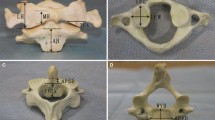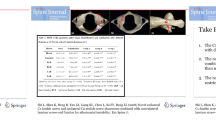Abstract
Purpose
C2 fixation is a demanding procedure, particularly in patients with variants of C1–C2 anatomy. The inferior articular process (IAP) of the axis can be an alternative for screw placement. We report the results of a CT study of C2 IAP anatomy and we present the clinical experience of 28 patients operated with this technique.
Methods
Anatomical study: 50 CT angiographies of the vertebral arteries (VA) were used for this study and, therefore, 100 IAPs were considered. We measured on the axial and sagittal planes the length, height and width of the facet, the distance between the anterior cortex and the VA and the distance between the screw entry point and the VA. We also measured the angle between the sagittal plane and the external tangent line of the VA. Clinical report: 28 patients were treated with C2 IAP screws at the Spine Surgery Department of the University Hospital in Lyon, France, from January 2014 to January 2016.
Results
Anatomical study: the mean length of C2 IAP was 12 ± 2 mm, the mean distance between the anterior cortical layer and the VA was 5.2 ± 1.4 mm, and the mean angle we found was 0.2° ± 5.3°. Clinical report: 16 of the 28 patients presented post-traumatic C1–C2 instability, 8 patients presented degenerative disease, 1 patient was treated for pseudoarthrosis, 1 for tumour, 1 for OPLL and 1 for rheumatoid arthritis. All the screws were correctly positioned and there was no VA injury.
Conclusion
IAP screws can represent a safe alternative option for C2 fixation.







Similar content being viewed by others
References
Huang DG, Hao DJ, He BR et al (2015) Posterior atlantoaxial fixation: a review of all techniques. Spine J 15:2271–2281
Menendez JA, Wright NM (2007) Techniques of posterior C1–C2 stabilization. Neurosurgery 60(Suppl 1):S103–S111
Mummaneni PV, Haid RW (2005) Atlantoaxial fixation: overview of all techniques. Neurol India 53:408–415
Holness RO, Huestis WS, Howes WJ, Langille RA (1984) Posterior stabilization with an interlaminar clamp in cervical injuries: technical note and review of the long term experience with the method. Neurosurgery 14:318–322
Hanimoglu H, Hanci L, Kaynar MY, Hanci M (2009) Bilateral C1–C2 claw for atlantoaxial instability. Turk Neurosurg 19:345–348
Gallie W (1939) Fractures and dislocations of the cervical spine. Am J Surg 46:495–499
Brooks AL, Jenkins EB (1978) Atlanto-axial arthrodesis by the wedge compression method. J Bone Jt Surg Am 60:279–284
Dickman CA, Sonntag VK, Papadopoulos SM, Hadley MN (1991) The interspinous method of posterior atlantoaxial arthrodesis. J Neurosurg 74:190–198
Harms J, Melcher RP (2001) Posterior C1–C2 fusion with polyaxial screw and rod fixation. Spine (Phila Pa 1976) 26:2467–2471
Goel A, Laheri V (1994) Plate and screw fixation for atlanto-axial subluxation. Acta Neurochir (Wien) 129(1–2):47–53
Yanni DS, Perin NI (2010) Fixation of the axis. Neurosurgery 66:A147–A152
Wright NM (2004) Posterior C2 fixation using bilateral, crossing C2 laminar screws: case series and technical note. J Spinal Disord Tech 17(2):158–162
Lucas F, Mitton D, Frechede B, Barrey C (2016) Short isthmic versus long trans-isthmic C2 screw: anatomical and biomechanical evaluation. Eur J Orthop Surg Traumatol. [Epub ahead of print] PubMed PMID: 27170334
Magerl F, Seemann PS (1986) Stable posterior fusion of the atlas and axis by transarticular screw fixation. In: Kehr P, Wiedner A, Cervical Spine Research Society (eds) Cervical Spine I. Springer, New York, pp 322–327
Farey ID, Nadkarni S, Smith N (1999) Modified Gallie technique versus transarticular screw fixation in C1–C2 fusion. Clin Orthop Relat Res 359:126–135
Peng CW, Chou BT, Bendo JA, Spivak JM (2009) Vertebral artery injury in cervical spine surgery: anatomical considerations, management, and preventive measures. Spine J 9:70–76
Lunardini DJ, Eskander MS, Even JL et al (2014) Vertebral artery injuries in cervical spine surgery. Spine J 14:1520–1525
Yoshida M, Neo M, Fujibayashi S, Nakamura T (2006) Comparison of the anatomical risk for vertebral artery injury associated with the C2-pedicle screw and atlantoaxial transarticular screw. Spine (Phila Pa 1976) 31:E513–E517
Tokuda K, Miyasaka K, Abe H, Abe S, Takei H, Sugimoto S, Tsuru M (1985) Anomalous atlantoaxial portions of vertebral and posterior inferior cerebellar arteries. Neuroradiology 27:410–413
Coyne TJ, Fehlings MG, Wallace MC, Bernstein M, Tator CH (1995) C1–C2 posterior cervical fusion: long-term evaluation of results and efficacy. Neurosurgery 37:688–693
Elliott RE, Tanweer O, Boah A, Morsi A, Ma T, Smith ML et al (2012) Atlantoaxial fusion with screw–rod constructs: meta-analysis and review of literature. World Neurosurg. doi:10.1016/j.wneu.2012.03.013
Roy-Camille R, Saillant G, Laville C et al (1992) Treatment of lower cervical spinal injuries—C3 to C7. Spine (Phila Pa 1976) 17:S442–S446
Jeanneret B, Magerl F, Ward EH et al (1991) Posterior stabilization of the cervical spine with hook plates. Spine (Phila Pa 1976) 16:S56–S63
An HS, Gordin R, Renner K (1991) Anatomic considerations for plate-screw fixation of the cervical spine. Spine (Phila Pa 1976) 16(10 suppl):S548–S551
Anderson PA, Henley MB, Grady MS et al (1991) Posterior cervical arthrodesis with AO reconstruction plates and bone graft. Spine (Phila Pa 1976) 16:S72–S79
Wang S, Wang C, Leng H, Zhao W, Yan M, Zhou H (2016) Pedicle screw combined with lateral mass screw fixation in the treatment of basilar invagination and congenital C2–C3 fusion. Clin Spine Surg. 29(10):448–453
Author information
Authors and Affiliations
Corresponding author
Ethics declarations
Conflict of interest
The authors report no conflict of interest concerning the scientific material and clinical data mentioned in this paper.
Informed consent
Informed consent was obtained from all individual participants included in the study.
Rights and permissions
About this article
Cite this article
Rusconi, A., Freitas-Olim, E., Coloma, P. et al. Bicortical facet screws as a new option for posterior C2 fixation: anatomical study and clinical experience. Eur Spine J 26, 1082–1089 (2017). https://doi.org/10.1007/s00586-017-4997-7
Received:
Revised:
Accepted:
Published:
Issue Date:
DOI: https://doi.org/10.1007/s00586-017-4997-7




